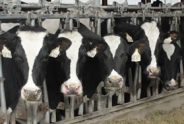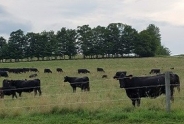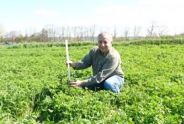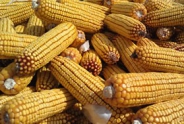Field Crop Update May 31-June 4, 2021
Erik Smith, Area Field Crop Specialist
Central New York Dairy and Field Crops
1. Field Observations
While almost all of us have taken first cutting, I noticed that as of a few days ago, some fields in the higher elevations (especially to the west of our region) still were not cut - though this may no longer be true as I type! As alfalfa begins to regrow, we will want to monitor the new growth for alfalfa weevil and potato leafhopper. I will monitor these pests in fields around the region starting next week, but it's easy enough to do yourself as well: Potato Leafhopper Scouting and IPM Thresholds in Alfalfa.
Winter grains are looking excellent, and crops I've seen in the lower Mohawk Valley area are nearing full anthesis - and this is the time to monitor or spray to prevent fusarium head blight in winter wheat if you've had trouble with it in the past. I've seen an abundance of crown rust on buckthorn trees, which means we should keep an eye on spring oats. A number of different rust species can infect buckthorn and not oats, so this is another pest that is difficult to forecast.
I have yet to see any cereal leaf beetle in the fields I've checked, but that doesn't mean it isn't out there. Our friends in western NY have seen a few fields with lots of leaf beetle mating activity, so if you see any in your field, please let me know! We need to collect some larvae to hopefully reinvigorate what was a very successful biocontrol program that has lost steam over the years. So keep me in the loop….
Soybean aphid has been spotted in other parts of the state, so this is another pest to watch for as we get into June. I'll be checking for it as I make my rounds, but the management threshold is an average of 250 aphids/plant if plant development is prior to early pod fill (R4). Natural enemies can keep lower populations in check, so we should resist the temptation to spray on first sight.
A few of you have mentioned some random, uniform inconsistency in no-till corn emergence this spring. When we dig down, the kernels have germinated but have not yet broken the soil surface. This can happen as a result of a number of factors: the usual rocks getting in the way of consistent planting depth and seed-soil contact, inconsistency in the moisture of the ground at planting due to intermittent rainfall that can affect germination timing or seed depth, or a slight variability in the vigor of the seed. Regardless, all of these cases have shown that the seed germinated successfully. Time will tell just how far behind these stragglers are, and if it will impact yield. Hopefully the recent rain and warm weather will help the stragglers catch up. Cold temperatures at night can slow emergence, but the forecast is telling us that we will not have that issue over the next 7-10 days.
2. Growing Degree Days as of June 2nd (See: Climate Smart Farming Growing Degree Day Calculator)
Growing degree days (GDD) are calculated by taking the average daily temperature and subtracting the base temperature for development of a given organism ((High + Low)/2 - base temp = GDD). For corn silage, we are using base 50/86, as corn development starts at 50 degrees F and ceases above 86.
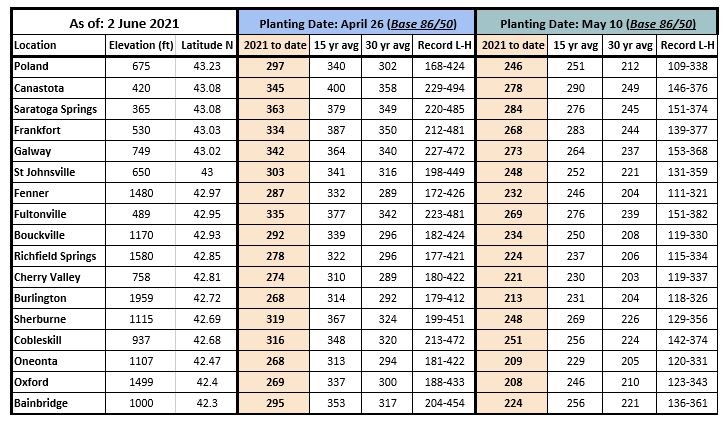
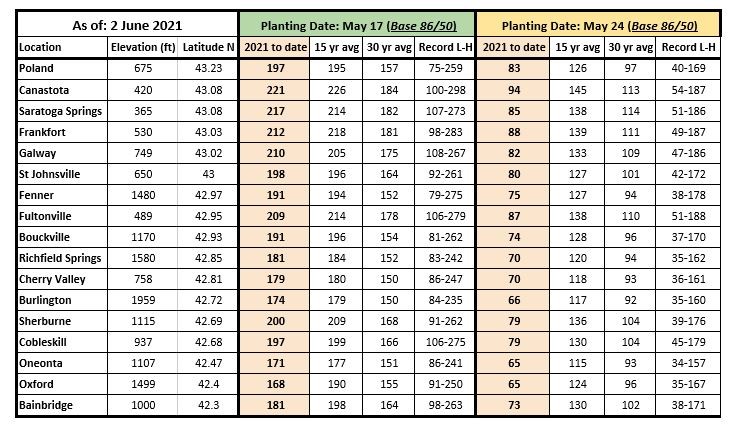
With the warm weather in the forecast, just about all of us can expect another 140-160 GDD over the next 7 days:
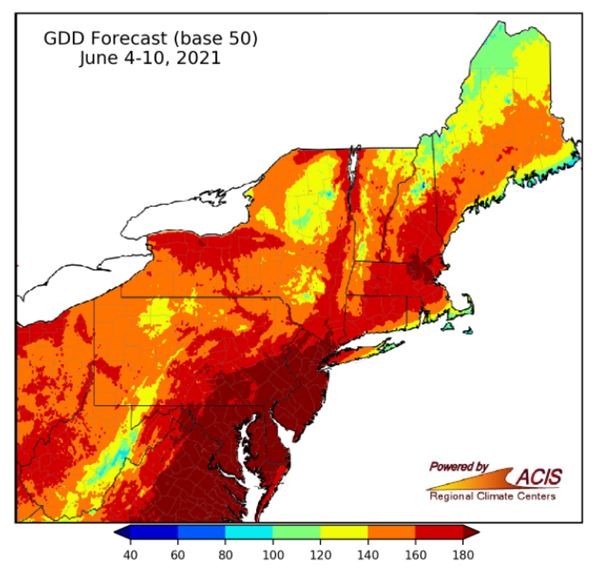
3. Pest Monitoring
This year we will again monitor for several pests of corn and soybean, including black cutworm, western bean cutworm, true armyworm, soybean cyst nematode, and the invasive soybean pests (and as-of-yet undetected) silver Y moth and golden twin spot moth.

Corn at V2 stage (2 fully emerged leaves with leaf collars) - 2 cut plants per 100
Trap captures of these pests have been relatively low across the state, with the exception of some locations in western NY and the north country (Lewis Co.). Cutting begins ~300 GDD (base 50) from moth capture, and the damage thresholds are as follows:
Corn at V3 stage (3 fully emerged leaves with leaf collars) - 3 cut plants per 100
Corn at V4 stage (4 fully emerged leaves with leaf collars) - 5 cut plants per 100
Corn at V5 stage (5 fully emerged leaves with leaf collars) - 7 cut plants per 100
The only point of reference for our region based on trap capture is the central Mohawk Valley where we captured our first moths around the beginning of May. We're at about 250 GDD for that region since then, so based on the forecast, we could begin to see cutting next week if there was substantial egg laying in the crop. There's no guarantee there will be, especially if your corn field is among other grassy habitats.
While we don't have data for other areas in the region, keep this in mind for your planting date and area (~300 GDD after moth capture/crop emergence). See this article for more information on damage and recommended products: NYS IPM Field Corn Pheromone Trapping Network for 2020 Caught Moths in Mid-April! - What's Cropping Up? Blog
Cutworm monitoring will continue for another week, after which we will continue monitoring true armyworm and begin to monitor for western bean cutworm in the pheromone traps. As I mentioned earlier, I will also begin monitoring alfalfa pests.
Enjoy the nice weather if you can, stock up on cold drinks, and bring the fans and A/C units out of storage!
I want to collect your fall armyworm adults and larvae! While Bt has done a good job of controlling fall armyworm on conventional corn here in the US, it's still a concern in our non-GMO corn and grass crops, and is a major invasive pest in other parts of the world. I'm teaming up with a group in southeast Asia who is studying this pest and its genetic variability around the world, so I'm looking for locations to place pheromone traps so I can collect specimens for them to evaluate. Let me know if you have a field that would be a good trapping candidate this summer, and regardless, please let me know if you encounter larvae:

We want to collect your cereal leaf beetle larvae! Many of you have had issues with cereal leaf beetle in small grains. In the late 1960s and 1970s, USDA released a parasitoid that controlled cereal leaf beetle at very high levels. It was established and did a good job for many decades. In some parts of NYS there are very low levels of these parasitoids left. We are looking to reestablish them in those areas. In 2020 NYS IPM (Jaime Cummings) conducted a survey on the percent parasitism of cereal leaf beetle larvae in several areas of the state. We are looking to conduct the same survey in 2021 as well as continuing to develop a parasitoid insectary refuge on the Cornell Farm in Aurora. This can help us reestablish the parasitoid in areas of the state that might need them. If you have cereal leaf beetle in your fields please let Erik Smith (eas56@cornell.edu) or Ken Wise (klw24@cornell.edu) know and we can come and collect them. We will also let you know the rates of parasitism of the beetles in your fields.
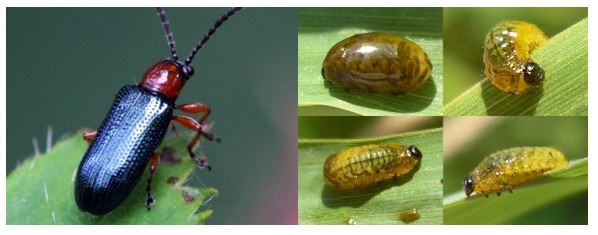
Field Crop Update May 31-June 4, 2021 (pdf; 430KB)
Upcoming Events
Fresh Cow Health Disorders - Spanish
July 19, 2024
July 26, 2024
August 2, 2024
August 9, 2024
August 16, 2024
August 23, 2024
August 30, 2024
Free webinar series in Spanish.
Calving Workshop
August 6, 2024 : Calving Workshop
Herkimer, NY
English / Spanish program. Limited to 8 English speaking & 8 Spanish speaking participants. Lunch included.
Announcements
Document and Share Storm Damage
Mother nature has really been difficult over the last few days. Significant damage has been seen throughout NYS. Please let us know what types of damage your farm may have sustained during this time. This could be in the form of property damage, lost power, milk dump due to lost power, loss of livestock, loss of stored feed or growing crops.Farms are encouraged to DOCUMENT AND SHARE any impacts the weather may have had on their home or business. This could include structure damage, crop loss, inventory loss due to power outages, damage to equipment or fencing, and more.
If your farm experienced any sort of damage, please reach out to any of the folks listed below (or all of them). The more impact information that is collected, the greater the likelihood of a disaster declaration which can bring vital emergency support and awareness. The CNYDLFC Team will continue to collect detail and submit to NYSDAM and the EDEN network.
Reporting Weather Related Impacts (For your home or farm business)
- First, ensure that all the people and animals on your farm are safe, and that there aren't any unsafe working conditions created because of the weather (check your structures!). If there's an emergency, call 911 - don't try to manage it all on your own.
- Second, document all negative weather impacts for your farm and their estimated financial cost. Take photos, make estimates, and put it all in a safe place.
- Reach out to your insurance providers - farm, vehicle, crop, etc. to initiate the claim process as needed.
- Then, share your farm's damage with any (or all) of the ag support agencies listed below. We all work together to collect storm damage information and funnel it up to Ag and Markets which can initiate a natural disaster declaration.
- Chenango: 607-334-5841
- Fulton/Montgomery: 518-853-2135
- Herkimer: 315-866-7920
- Madison: 315-684-3001
- Otsego: 607-547-2536
- Schoharie: 518-234-4303
- Saratoga: 518-885-8995
- Nicole Tommell: 315-861-6001
- Erik Smith: 315-219-7786
- Daniela Gonzalez: 315-749-3486
- Ashley McFarland- 315-604-2156
Your county USDA/FSA service center.
- Chenango: 607-334-3231
- Fulton/Montgomery: 518-853-4015
- Herkimer: 315-866-2520
- Madison:315-824-9076
- Otsego: 607-547-8131
- Schoharie: 518-295-8600
- Saratoga: 518-692-9940
Your county farm bureau manager
- Region 3: Bailey Coon: 518-937-0566
- Region 5: John Wagner: 315-761-9770
- Region 6: Natally Batiston: 518-937-0269
- Region 7: Todd Heyn: 518-431-9338
Please let us know how we can help you.
Cash Rent and Custom Harvest Survey
To date, there is limited information available about rental rates and fees for crop harvesting. Farms can use this valuable information for their farm business planning to help improve decision making and profitability.Farmers Can Join MeatSuite For Free!
MeatSuite.com is a free resource provided by Cornell University where NY meat farmers can create a farm profile and list their bulk (wholes, halves, quarters) and bundled (i.e. Grilling Bundle) meat products.Why should farmers join?
1. It's free and easy!
2. Connect with more local customers. In the past year the MeatSuite.com farm directory had 8,300 visits from New York consumers. Farm profiles get as many as 25 views per month from potential local customers. We also spotlight MeatSuite farms on social media and bring attention and purchases to farms through highlights and giveaways.
How do I join?
Farmers can visit https://www.meatsuite.com/farmers/ to create a free farm profile. You must list at least one product for your farm's profile to go live. You'll also have access to Cornell's free Meat Price Calculator, a helpful tool for pricing your meat to make a profit.
While you're on MeatSuite, check out the "Creating Consumer-Friendly Bulk Meats" publication on the log-in page. It has tips on how to create bulk meat products that are easier for first-time buyers to say "yes" to.
If you have any questions as you create your farm profile or products, we're here to help! Please email Matt LeRoux at mnl28@cornell.edu.

